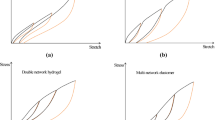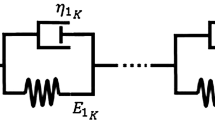Abstract
Giant magnetostrictive actuators are suitable for applications requiring large mechanical displacements under low magnetic fields; for instance Terfenol-D made out of rare earth-iron materials can produce important strains. But these actuators exhibit hysteretic non-linear behavior, making it very difficult to experimentally characterize them. Therefore, sophisticated numerical algorithms to develop computational tools are necessary. In this work, theoretical and numerical formulations within the finite element method are developed to simulate magnetostriction. Theoretically, within the framework of non-equilibrium thermodynamics, the hysteresis is introduced by the Debye-memory relaxation. Numerically, the main novelty is the time integration, coupled Newmark-\(\beta \) (for mechanical) and convolution integrals (for magnetic constitutive equations); the non-linearity is solved with the standard Newton–Raphson algorithm. Constitutive non-linearities are incorporated with the Maxwell stress tensor, quadratically dependent on the magnetic field. The numerical code is validated using analytical and experimental solutions; several examples are presented to demonstrate the capabilities of the present formulation.








Similar content being viewed by others
References
Orszulik RR, Gabbert U (2015) An interface between Abaqus and Simulink for high-fidelity simulations of smart structures. IEEE/ASME Trans Mechatron 21(2):879–887
Melchor J, Rus G (2014) Torsional ultrasonic transducer computational design optimization. Ultrasonics 54(7):1950–1962
Khan FU, Ahmad I (2016) Review of energy harvesters utilizing bridge vibrations. Shock Vib 2016:1–21
Melingui A, Lakhal O, Daachi B, Bosco J, Merzouki R (2015) Adaptive neural network control of a compact bionic handling arm. IEEE/ASME Trans Mechatron 20(6):2862–2875
Anjanappa M, Bi J (1994) A theoretical and experimental study of magnetostrictive mini-actuators. Smart Mater Struct 3:83–91
Anjanappa M, Bi J (1994) Magnetostrictive mini actuators for smart structure applications. Smart Mater Struct 3:383–390
Venkataraman R, Rameau J, Krishnaprasad PS. Characterization of an ETREMA MP 50/6 magnetostrictive actuator, TR 98-1. Technical report of the Institute for System Research, University of Maryland at College Park
Li Z, Zhang X, Gu GY, Chen X, Su CY (2016) A comprehensive dynamic model for magnetostrictive actuators considering different input frequencies with mechanical loads. IEEE Trans Ind Inform 12(3):980–990
Pérez-Aparicio JL, Sosa H (2004) A continuum three-dimensional, fully coupled, dynamic, non-linear finite element formulation for magnetostrictive materials. Smart Mater Struct 13:493–502
Perez-Aparicio JL, Palma R, Taylor RL (2016) Multiphysics and thermodynamic formulations for equilibrium and non-equilibrium interactions: non-linear finite elements applied to multi-coupled active materials. Arch Comput Methods Engieering 23(3):535–583
Kannan KS, Dasgupta A (1997) A non-linear Galerkin finite-element theory for modeling magnetostrictive smart structures. Smart Mater Struct 6:341–350
Kiang J, Tong L (2010) Nonlinear magneto-mechanical finite element analysis of Ni–Mn–Ga single crystals. Smart Mater Struct 19:1–17
Zhou P (2015) On the coupling effects between elastic and electromagnetic fields from the perspective of conservation of energy. arXiv:1512.04487
Natale C, Velardi F, Visone C (2001) Identification and compensation of Preisach hysteresis models for magnetostrictive actuators. Phys B Condens Matter 306(1):161–165
Kaltenbacher M, Meiler M, Ertl M (2009) Physical modeling and numerical computation of magnetostriction. Int J Comput Math Electr Electron Eng 28(4):819–832
Linnemann K, Klinkel S, Wagner W (2009) A constitutive model for magnetostrictive and piezoelectric materials. Int J Solids Struct 46:1149–1166
de Groot SR, Mazur P (1984) Non-equilibrium thermodynamics. Dover, Mineola
Pérez-Aparicio JL, Palma R, Moreno-Navarro P (2016) Elasto-thermoelectric non-linear, fully coupled, and dynamic finite element analysis of pulsed thermoelectrics. Appl Therm Eng 107:398–409
Taylor RL (2010) FEAP a finite element analysis program: user manual. University of California, Berkeley
Jiménez JL, Campos I, López-Mariño MA (2013) Maxwell’s equations in material media, momentum balance equations and force densities associated with them. Eur Phys J Plus 128(46):1–6
Sardanashvily G (2016) Noether’s theorems. Applications in mechanics and field theory. Springer, Berlin
Landau LD, Lifshitz EM (1984) Electrodynamics of continuous media. Pergamon Press Ltd, Oxford
Juretschke HJ (1977) Simple derivation of the Maxwell stress tensor and electrostictive effects in crystals. Am J Phys 45(3):277–280
Palma R, Pérez-Aparicio JL, Taylor RL (2019) On the non-symmetry of the Maxwell stress tensor: a generalized continuum mechanics approach. Int J Eng Sci (submitted)
McMeeking RM, Landis CM (2005) Electrostatic forces and stored energy for deformable dielectric materials. J Appl Mech 72:581–590
Reitz JR, Milford FJ, Christy RW (1960) Foundations of electromagnetic theory. Addison-Wesley Publishing Company, Inc, Boston
Palma R, Pérez-Aparicio JL, Taylor RL (2017) Dissipative finite element formulation applied to piezoelectric materials with Debye memory. IEEE/ASME Trans Mechatron 23(2):856–863
Zienkiewicz OC, Taylor RL, Zhu JZ (2013) The finite element method: its basis and fundamentals, 7th edn. Elsevier, Oxford
Moffett MB, Clark AE, Wun-Fogle M, Linberg J, Teter JP, McLaughlin EA (1991) Characterization of Terfenol-D for magnetostrictive transducers. J Acoust Soc Am 89(3):1448–1455
Telesnin RV, Shishkov AG (1958) Effect of magnetic viscosity on the frequency properties of ferrites. Sov Phys JETP 6(33):649–652
Cole KS, Cole RH (1941) Dispersion and absorption in dielectrics—I alternating current characteristics. J Chem Phys 9(4):341–352
Gualdi AJ, Zabotto ML, Garcia D, Bhalla A, Gu R, de Camargo PC, de Oliveira AJ (2016) Understanding the dynamic magnetization process for the magnetoelectric effect in multiferroic composites. J Appl Phys 119(12):4110
Author information
Authors and Affiliations
Corresponding author
Additional information
Publisher's Note
Springer Nature remains neutral with regard to jurisdictional claims in published maps and institutional affiliations.
Appendix
Appendix
For the FE implementation, the tangent stiffness \(\varvec{\mathcal {K}}\) and mass \(\varvec{\mathcal {M}}\) matrices may be explicitly expressed as:
First, the mechanic and magnetic derivatives are calculated using (32) and (5) along with (10):
Second, the time-dependent derivatives for the magnetic induction are obtained from (39) to give:
Finally, this numerical formulation is implemented in the FE research software FEAP [19].
Rights and permissions
About this article
Cite this article
Palma, R., Pérez-Aparicio, J.L. & Taylor, R.L. Non-linear and hysteretical finite element formulation applied to magnetostrictive materials. Comput Mech 65, 1433–1445 (2020). https://doi.org/10.1007/s00466-020-01828-y
Received:
Accepted:
Published:
Issue Date:
DOI: https://doi.org/10.1007/s00466-020-01828-y




